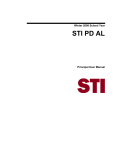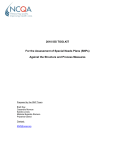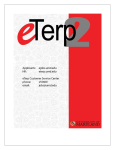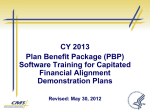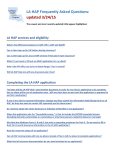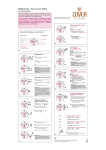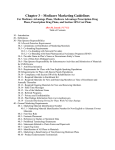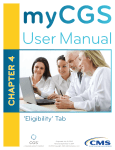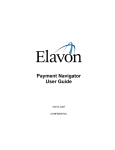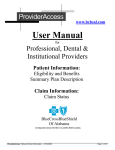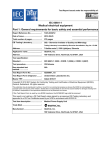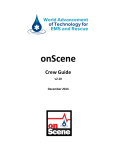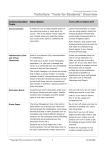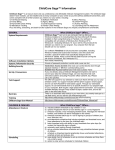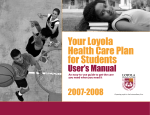Download CMS Responses to Previously Asked Questions
Transcript
CMS Responses to Previously Asked Questions (CY 2015) PBP/Data Entry 1. Q. We have some PBP categories that require prior authorization (PA) over a certain number of visits. As we are entering our benefits, we are looking for ways to standardize our entry and notes wherever we can. For notes regarding prior authorization, can we use the following standard note? "PA required for selected services, contact Plan for details." A. Since you are requiring a prior authorization after a certain number of visits for some categories, the following would satisfy our requirements: "PA required after a certain number of visits for selected services. Enrollees will be instructed to contact Plan for details in marketing materials." 2. Q. Please verify that the min/max fields are to be used to show tiered cost sharing, along with an appropriate note describing tiers for the service category. If not, please provide guidance on how to enter tiered cost sharing in the PBP. A. That is correct. The min/max fields in the PBP are to be used to show tiered cost sharing of medical benefits, along with an appropriate note describing the tiers for the service category. All plans (not just plans tiering medical benefits) can use min/max fields to indicate a range of cost sharing within a service category along with appropriate note descriptions. Please review requirements related to tiered cost sharing for medical benefits in the Final Call Letter (April 7, 2014, page 98) and the HPMS Memo titled “CY 2015 MA Bid Review and Operations Guidance” (April 14, 2014, page 14). 3. Q. Please confirm whether MAOs are expected to enter cost sharing in PBP category 9a (OP Hospital) for services included in the bid under categories 8a/8b (lab, x-rays and diagnostic tests.) Entering cost sharing for the same services within multiple categories of the bid is inconsistent with bid pricing and leads to very confusing SB sentences, so if possible we would like to enter only the 9a cost sharing in the 9a cost sharing section. To use a specific example, if a plan’s cost sharing is $200 for 9a OP Hospital services, 20% for 8a diagnostic tests, $10 on 8a lab, $20 on 8b xray and 20% on 8b other radiological services in the 2015 PBP should we enter in the PBP category 9a “$200”, “$200 or 20%”, or “$10-200 or 20%”? A. Plans may enter only the 9a Outpatient Hospital Services cost sharing in the 9a cost sharing section. Based on the example, a plan should enter $200 in PBP service category 9a. 4. Q. Both Sections 8a and 8b in the PBP seem to address "diagnostic procedures". The Summary of Benefits sentences that are generated indicate that only 8a generates a sentence that reflects "diagnostic procedures". Is Section 8a intended to address Lab Test and "all other diagnostic procedures", or is 8b intended to also reflect some other diagnostic procedures such as EKGs, treadmill tests, and sleep studies. We know some diagnostic procedures could fall under either. Given the fact that 8a is the only section generating a Summary of Benefits sentence that reflects diagnostic procedures is it your intention that Section 8a capture all diagnostic procedures. 1 A. Yes. Plans should capture diagnostic procedures such as EKGs, treadmill tests, and sleep studies in 8a-Outpatient Diagnostic Procedures and Tests and Lab Services. Only Outpatient Diagnostic and Therapeutic Radiological services should be captured under 8b. 5. Q. Our organization offers several PBPs with FFS Medicare cost sharing designed for D-SNPs and employer groups. I understand that if a MA plan charges a plan co-pay for inpatient hospital service, that copay has to be all-inclusive, over Part A hospital and Part B physician (i.e., no separate copay is allowed for Part B services in the hospital). For MA plans that are designed to charge FFS Medicare cost-share in the PBP, are we supposed to charge separate FFS Part A deductible/copay and Part B coinsurance for a hospital stay? Are we allowed to charge these separate Part A and B cost-shares just like FFS Medicare or do we have to waive the Part B coinsurance? In practice, the members who are dual eligible are not paying any copay, but this affects how we are supposed to pay the providers. A. The Cost Sharing Standards can be found in the April 7, 2014 Call Letter. For purposes of beneficiary cost sharing, a plan may charge cost sharing for inpatient hospital, but all inpatient fees are bundled and plans may not unbundle professional charges. MA organizations are permitted to have contracts with facility and professional providers for the purpose of reimbursement. 6. Q. On page 108 of the CY 2015 Bid User's Manual, it says that plans choosing the standard bid option for Section B will have 35% coinsurance for Outpatient Mental Health Care populated in the PBP. Our PBP reports are showing 20% for 7e and 7h. The PBP does not limit the coinsurance values for 7e and 7h below 50%. What is the correct coinsurance for Mental Health benefits for plans offering the standard Medicare benefits? A. Thank you for informing us of the error in the Bid User's Manual. We are working to correct this error. The standard bid value based on Original Medicare for Psychiatric and Mental Health Specialty Services for PBP Service Category 7e and 7h is 20% coinsurance or a $40 copay. 7. Q. The revised Summary of Benefits lists the benefits filed in 9A- Outpatient Services in the PBP software under the benefit category “Outpatient Surgery”. Should plans follow the guidance in the PBP software for determining the cost shares to include in this range for filing or should plans only file the Outpatient Hospital Surgery benefit as the revised Summary of Benefits would suggest? A. Outpatient Hospital Services covers Medicare Part B diagnostic and treatment services in participating hospital outpatient departments. Plans should follow the PBP software questions indicating the maximum enrollee out-of pocket amount or coinsurance amount for all therapeutic and diagnostic services furnished by hospitals to patients in this setting. 2 Supplemental Benefits 8. Q. We would like to offer an optional supplemental package that may include preventive dental, eyeglasses, hearing aids and/or fitness benefits. We know that members who choose an optional supplemental benefit are not obligated to keep this benefit for the entire benefit year and can request disenrollment from that benefit with a 30 day notice. We are trying to determine if we can accumulate a dollar amount for the benefit based on the number of months that the member pays a premium. For example – an annual eyeglass benefit has a maximum of $240 or $20 per month enrolled in the optional supplemental benefit package. Based on this maximum, the member would accumulate a $120 benefit if member paid 6 months of premium. A. MAO's that intend to offer Supplemental Benefits during open enrollment must offer the Optional Supplemental benefits for the first 30 days. The plan then has the option of not offering the Optional Supplemental benefits for the rest of the year or offering the benefits for the rest of the year. The plan must establish its policy on when the enrollee can purchase the optional supplemental benefits. CMS does not allow, in the example provided, the accrual of monies for a benefit. The benefits must be offered and available; however, the MAO can set limits to the supplemental package. 9. Q. Currently under 14c the category is labeled "Web/Phone-based Technology". The call letter mentions that real-time audio and video technologies are permitted - should these be included in the web/phone-based technology under 14c or in 13-other? The call letter also mentions that plans can propose new technologies - would these appear in 13-other? Please clarify. A.If the technology offered builds upon a benefit such as Web/Phone-based Technology that is defined in Chapter 4 of the MMCM, the benefit should be included under 14c in the PBP and described in the notes. If the plan is proposing a new technology that is not addressed in Chapter 4, that benefit should be included under 13-other and described in the notes. Meaningful Difference 10. Q. How will CMS test OOPC for a HMOPOS that covers all Part A and B services but limits coverage to a specified dollar limit (e.g., $3,000 annually)? Will the plan be grouped with HMO plans for OOPC testing or tested with HMOPOS plans? If the amount of the limit is important regarding this issue, what is the minimum limit necessary to be tested with HMOPOS plans rather than HMO plans? A. As stated in the April 7, 2014 Call Letter, page 86, an HMO-POS plan that covers all Part A and Part B services outside of the network will continue to be considered meaningfully different from an HMO plan. The plan described in the question would be evaluated with other HMO-POS plans offering all Part A and Part B services. 11. Q. The guidance we have found says regarding the meaningful difference test for Part C, there "...must be a combined Part C and D OOPC difference of at least $20 PMPM." Is it a correct 3 interpretation of the guidance that Part B premium reduction is not included in the calculation of meaningful difference? A. For purposes of the meaningful difference evaluation, Part B premium reduction is not included in the calculation. Please note that information regarding Meaningful Difference can be found in the (CY) 2015 Final Call Letter on pages 86-87. 12. Q. Can you please provide clarification regarding at what level (contract level or parent level) meaningful difference will be evaluated? In other words, in the context of the meaningful difference section of the final call letter, does “MAO” mean each Medicare Advantage contract, or Medicare Advantage parent company? Please see attachment for additional details. A. For purposes of the Part C meaningful difference evaluation, we review plans at the contract level unless there is a unique situation. Please refer to the final Call Letter for detailed information regarding meaningful difference requirements. 13. Q. Do you consider the service area when conducting the evaluation of the meaningful difference? If I have 3 HMO plans that are all MA-PD and provide services in different counties, would those plans be evaluated separately? A. As stated in the Final CY 2015 Call Letter on page 86, "CMS will evaluate meaningful differences among CY 2015 non-employer and non-cost contractor plans offered by the same MAO, in the same county,...." In your specific case, all MA-PD plans of the same plan type offered in the same county will be evaluated together. Other 14. Q. My question references the HPMS Memo issued April 14, 2014; "Contract Year 2015 Medicare Advantage Bid Review and Operations Guidance," in the area titled HMOPOS Geographic/provider restrictions (Section C), on page 9. Section C of the PBP has a new question for 2015, "Does this POS benefit include all practitioners who are state-licensed or state-certified to furnish the services?” Please confirm that the requirement of certified Medicare provider, as found in 1852(a)(1)(A) of the Act and 42 CFR 422.204(b)(3), remains in place. In other words, confirm the intent that the state-licensed or state-certified practitioners/providers must also be certified Medicare practitioners/providers. A. With respect to institutional providers (e.g., hospitals, SNFs DME suppliers), MA plans are required to contract with Medicare certified providers. However, physicians and practitioners can contract with and furnish services to MA enrollees as long as they are eligible to participate in Original Medicare, that is, they must be practicing within the scope of their state license and are not excluded from Medicare. 4 15. Q. Is it permissible for a plan to vary specialist visit cost sharing by specialty? In particular, for a plan that is a Chronic SNP, can cost sharing be reduced for specialist visits to the specialties associated with the SNP in order to reduce the cost sharing burden on the member (for example, for a cardiovascular SNP, could a reduced cost sharing be applied to cardiologist visits)? A. It is permissible to enter a copay range in the PBP service categories. Then, in the notes section, the plan is expected to further explain the range of cost sharing that would be associated for that service and when those cost sharing would apply to the enrollee. Be mindful, that you still need to comply with the Part C cost-sharing standards as stated in the CY 2015 Call letter (pages 90-93) and the in-network services cost sharing cannot exceed the standards. 16. Q. There is a table on page 92 of the 2015 Final Call Letter that shows that the member liability for plans with the maximum MOOP is $0 for days 1 – 20 and $156.50 for days 21 – 100. This also has a footnote that says that “MA plans may have cost sharing for the first 20 days of a SNF stay.” The footnote goes on to say that the per day copay cannot be higher than Original Medicare and taken together (days 1 – 20 and days 21 – 100) cannot have cost sharing that is actuarially greater than Original Medicare. In the past, we have used a flat cost sharing for all days (1 – 100). These copays have ranged from $25 to $50 per day depending upon the plan. This was determined to comply with the “actuarial equivalence or better” requirement. Is this benefit structure still permitted if we can show that it is actuarially equivalent or better (lower cost for the member than Original Medicare)? A. Depending upon the MOOP type (voluntary or mandatory) as defined on pages 88 and 89 of the Final Call Letter, it is possible that a plan could have the same per day copay amount throughout the entire SNF benefit (days 1 through 100) and satisfy our requirements. The chart on page 92 of the Final Call Letter indicates that copays for SNF days 1 through 20 are not permitted for plans that qualify as a Mandatory MOOP, while plans that qualify as a Voluntary MOOP can have a copay up to $40 per day. For SNF days 21 through 100, no plan can have a copay per day greater than the $156.50 limit. The overall SNF benefit that includes days 1 through 100 must also satisfy the PMPM actuarial equivalent cost sharing limits described on pages 89 and 91 of the Final Call Letter. 17. Q. In a PPO plan where the plan sponsor’s intent is to follow Original Medicare cost sharing as closely as possible, the PBP includes the deductible options “Medicare-Defined Part A and B deductible amount combined as a single deductible” and under “How is your combined Medicare-defined Part A and B Deductible applied?” the plan sponsor may select “Differentially applied to Part A and Part B Medicare services, reflecting Original Medicare payment structure”. We believe that CMS’s intent is to allow plans to continue to administer Part A deductibles on a benefit period basis. Please confirm that for PPO plans, the Part A deductible amount may be assessed per each benefit period both in-network and out-of-network. A. Consistent with past years, plans can either continue to administer Part A deductibles on a benefit period basis and the Part A deductible amount may be assessed each benefit period OR plans can establish an annual deductible. 18. Q. Are there any limitations on the number of plans that an organization can have by contract? 5 A. There are no limits to the number of plans that an organization can have by contract as long as they satisfy CMS requirements (e.g., meaningful difference evaluation). Chapter 4 of the Medicare Managed Care Manual Part I provides information on benefits that are needed by plans when designing and preparing plan benefits packages. 19. Q. The CY 2015 Final Call Letter (page 93) states, “Please note MAOs with benefit designs using a coinsurance or copayment amount for which CMS does not have an established amount (e.g., coinsurance for inpatient or copayment for durable medical equipment) must submit with their initial bid a document that clearly demonstrates how the coinsurance or copayment amount satisfies CMS service category requirements.” The 2015 Final Bid Instructions (page 111), found in Appendix B, also states the following requirement for documentation: “A detailed demonstration that coinsurance or copayment amounts for which CMS does not have an established amount (such as coinsurance for inpatient or SNF, or copayment for durable medical equipment) satisfies CMS service category requirements (Worksheet 3).” a. In demonstrating, for example, that a benefit using a coinsurance satisfies the service category requirements for a copayment, should we use our internal data to demonstrate the effective copayment meets the requirements? If not, does CMS have any recommended sources for unit cost data that can be used to compare copayments against coinsurance for the benefit categories covered listed in the cost sharing limits? b. Do plans that use Original Medicare benefits automatically satisfy the In-Network Service Category Cost Share Requirements? We recognize that the benefits in these plans use coinsurance amounts, where many of the cost share requirements use a copayment amount. If yes, is it then necessary for us to demonstrate that Original Medicare benefits meet the InNetwork Service Category Cost Share Requirements? A. a. MAOs can use their internal data to demonstrate that the effective copayment meets the requirements. b. We anticipate that if you use the Original Medicare cost sharing, that it will satisfy the Part C Cost Sharing Standards. Please keep in mind that all proposed benefits must satisfy all CMS requirements. 20. Q. In the 2015 PBP software the Summary of Benefits printout has changed. One area of concern for our plan with the elimination of the Original Medicare section is the loss of some categories that have showed in the past. One area is now seeing our POS benefits showing as Out-ofNetwork where in the past it did not show this way. This is seen as something that will cause confusion for our members. The other item that is concerning is the elimination of the Wellness/Education and Other Supplemental Benefits & Services especially in light of the addition of the Bathroom Safety Devices to this section where we can enter cost sharing and a benefit specific maximum amount of coverage. Also concerning is that we are not able to see the fitness benefit in the text produced. Since we only have 300 characters to go into more detail on the benefits, this is very limiting when looking to clearly state benefits. 6 A. HMOs may offer a POS option as a mandatory or optional supplemental benefit. This supplemental benefit may not be offered by any other plan type. The POS benefit provides coverage for some plan-covered services outside of the HMO's network. Please see Chapter 4, Medicare Managed Care Manual, Section 30.3. PBP category 14c will not generate Summary of Benefits sentences. Each of the service categories has a free form text area with a 300 character limit to describe the benefit. Plans have the option to include an additional section within the Summary of Benefits to describe their benefits further (this is the former SB section III). Instructions regarding character limits in the Summary of Benefits will be forthcoming. 21. Q. In the HPMS Memo issued on April 14, 2014, titled “CY 2015 MA Bid Review and Operations Guidance," section titled Cost Sharing for Special Needs Plans Serving Dual-Eligibles (D-SNPs)" you state that the MA organization must attest that no supplemental service duplicates other coverage that the member has. In the event that a Dual SNP operates in a state where virtually all of the major non Medicare benefits are covered for Duals, and the Dual SNP does not receive funding from the state to provide the service, can the Dual SNP provide supplemental benefits that the member could also receive thru their state Medicaid benefits and include those benefits in the PBP? (e.g., many Duals have Medicaid dental benefits, but they might prefer the health plan's dental network to the state Medicaid dental network). A. It may be possible for an MA D-SNP to offer certain benefits which may be similar to State Medicaid benefits through the MA D-SNP’s supplemental benefits. In the required contracting between the D-SNP and the State, we have issued guidance that States may choose to negotiate with the MA organization to cover certain Medicaid benefits under the organization’s MA contract with CMS, if the benefits in question are allowable under Medicare. For example, a State could negotiate with MA D-SNPs to offer hearing and vision services, which are Medicaid benefits in the State, through the D-SNP contracts. Also, under CMS’ benefits flexibility initiative, we allow certain D-SNPs that qualify as highly integrated D-SNPs, as described in Chapter 16b of the Medicare Managed Care Manual at section 40.4.4, to offer additional supplemental benefits pursuant to the regulations at 42 CFR §422.102(e). Examples of the benefits that can be offered under this additional flexibility are described in Chapter 16b. However, please note that MA organizations are required to attest in their PBP that the additional supplemental benefit(s) that the SNP describes do not inappropriately duplicate an existing service that enrollees are eligible to receive under the State Medicaid plan. This segregation of Medicare benefits in the review of the PBP is necessary so that CMS can appropriately account for the Medicare benefit package and costs to the Medicare program. 7







